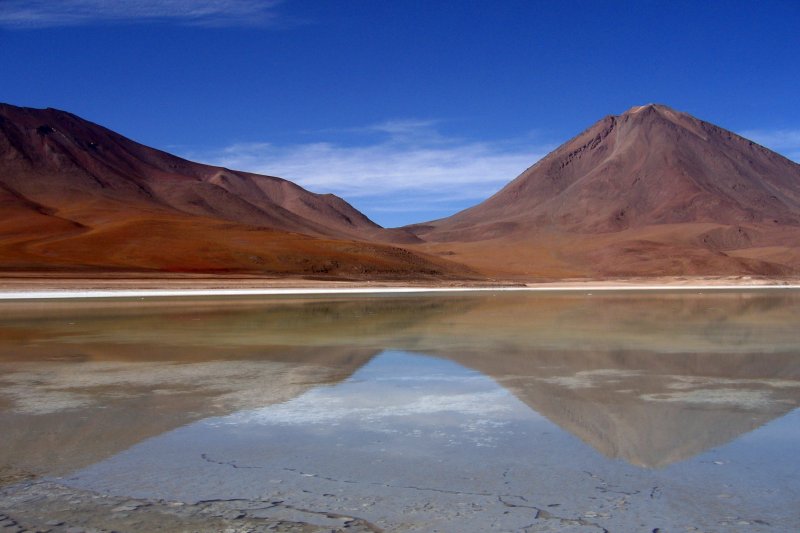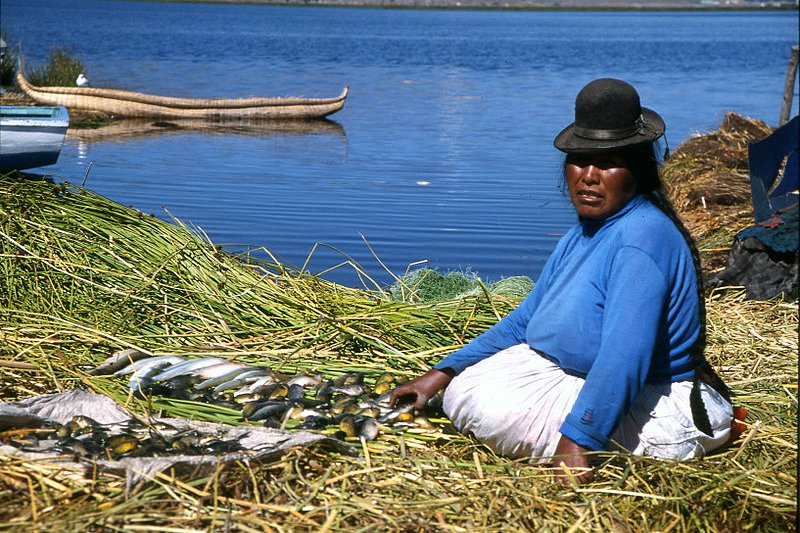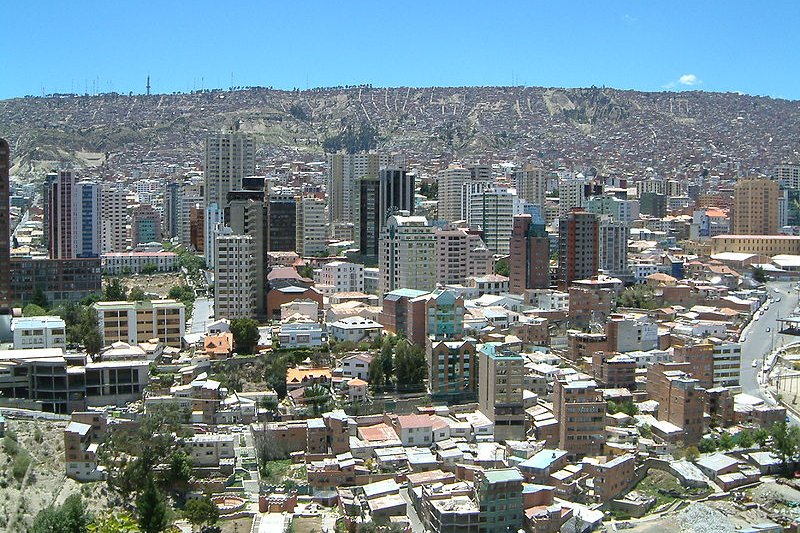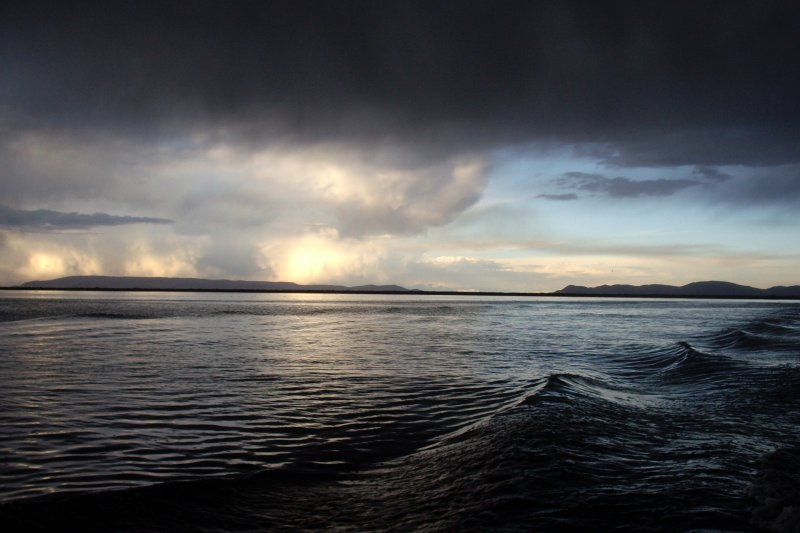 Laguna Verde, Bolivia
Laguna Verde, BoliviaSource: https://commons.wikimedia.org/wiki/File:Laguna_Verde1,_Bolivia.jpg
Author: Entropy1963

Places in Bolivia on this website
Bolivia is a landlocked country in South America. It was named after the Simón Bolívar, a Venezuelan political leader who led Bolivia, Colombia, Ecuador, Panama, Peru and Venezuela to independence. The country is bordered by Brazil to the north and east, Paraguay and Argentina to the south, and Chile and Peru to the west. Bolivia covers an area of 1,098,581 square kilometers (424,163 sq miles), roughly twice the size of Texas, but has a population of only 10 million people.
 A native on a floating island at Lake Titicaca, Bolivia
A native on a floating island at Lake Titicaca, BoliviaSource: https://commons.wikimedia.org/wiki/File:Titicaca_9921a.jpg
Author: Yves Picq

The capital of Bolivia, La Paz, is the highest capital in the world. With a population of 835,000, is not the biggest city, rather the third behind Santa Cruz (1,450,000) and El Alto (860,000).
The highest peak in Bolivia is Nevado Sajama, at 6,542m (21,463 ft). Lake Titicaca, the world's highest navigable lake, sits on the border between Bolivia and Peru, at an elevation of 3,805m. On the southwest of Bolivia is Salar de Uyuni, the world's largest salt flat.
The majority of the population of Bolivia are South Americans speaking Quechua and Aymara. After breaking away from Spain in 1825, Bolivia has gone through close to 200 coups and counter coups. Although a nation rich in natural resources - it has the second largest natural gas field in South America after Venezuela - Bolivia is still the poorest country in the continent, with the lowest GDP in South America.
 La Paz, Bolivia
La Paz, BoliviaSource: https://commons.wikimedia.org/wiki/File:La_Paz-center.jpg
Author: Paul Richter

Fast Facts about Bolivia
- Official Name: Republic of Bolivia
- Capital: La Paz (812,000)
- Population of Bolivia: 8,857,900
- Languages: Spanish (official), Quechua, Aymara, others
- Currency: Boliviano (BOB)
- Religions: Roman Catholic (95%), Protestant (5%)
- Size: 1,098,580 sq km (424,164 sq miles)
- Region: South America
Planning your visit to Bolivia
You will encounter every climatic zone in Bolivia, from the hot tropics to arctic cold to semi-arid regions.Summers are wet, and roads muddy and travel difficult. Best ideal time to explore Bolivia is in winter, from May to October, as you are more assured of dry weather and clear skies. The peak period for travelling to Bolivia is from late June to early September. That's when you can view most of Bolivia's major festivals. However, it is also summer vacation time in Europe and North America, so this period may see higher prices than the rest of the year.
Travel Warning
Street demonstrations are fairly common in Bolivia, and have a tendency of becoming violent. By all means, stay away from them. The resulting effect of such demonstrations is road blockades that will disrupt your itinerary. This is fairly frequent for the road between La Paz and Cochabamba, and the blockade that last for days. Check local news updates and avoid volatile areas.
What to wear
Lightweight clothing is good enough for the day time. You will need warmer clothes, if you are in the Altiplano and the Puna regions, including La Paz, Oruro and Potosi.Getting into Bolivia
By PlaneEntering Bolivia by air is going to be a challenge since the national airline of Bolivia, Lloyd Aereo Boliviano, suspended services in March 2007 due to financial difficulties. Presently you can enter Bolivia taking American Airlines from Miami.
The La Paz International Airport (LPB) is located 14km southwest of La Paz, and coach services to the city is available whenever there are scheduled flights. There's a departure tax of US$25 payable when on your departure flight.
Planning your travel within Bolivia
Transportation strikes are fairly common in Bolivia, and can disrupt your plans, so keep yourself updated to the local news. In Bolivia, be prepared for general delays and unreliabilities of schedules. Cross country bus rides are fairly cheap, but often they only travel at night. Stormy clouds over Lake Titicaca
Stormy clouds over Lake TiticacaSource: https://commons.wikimedia.org/wiki/File:Tormenta_titicaca.JPG
Author: Pallares1

Principal Cities of Bolivia
- La Paz
Capital and second largest city in Bolivia. The La Paz Metropolitan Area is however the most populous urban area in the country. - Cochabamba
Located in an Andean valley in central Bolivia, Cochabamba is the fourth largest city in the country. - Copacabana
Major town on the shores of Lake Titicaca. - Coroico
Small town in La Paz Department. - Oruro
Town between La Paz and Sucre, the center of the most important tin-mining in Bolivia. - Potosí
Town that was once an important silver-mining center in the country. - Rurrenabaque
Gateway town to Madidi National Park. - Santa Cruz de la Sierra
The largest city as well as the most prosperous in Bolivia. - Sucre
Constitutional capital of Bolivia, Sucre is very Spanish in character, with elements of Andalusian culture in its architecture. The inner city, titled the Historic City of Sucre, is a World Heritage Site. - Tarija
Town in the Andean highlands founded by the Spanish in 1574. - Uyuni
Gateway town to the salt flats of Salar de Uyuni.
Major Attractions of Bolivia
- Lake Titicaca
The highest commercially navigable lake in the world. - Salar de Uyuni
Biggest salt pan in the world. - Laguna Verde
Huge salt lake in the Altiplano of Bolivia. - Cristo de la Concordia
The tallest statue of Christ in the world.
 Latest updates on Penang Travel Tips
Latest updates on Penang Travel Tips

Copyright © 2003-2025 Timothy Tye. All Rights Reserved.

 Go Back
Go Back